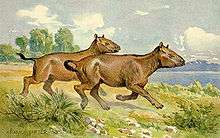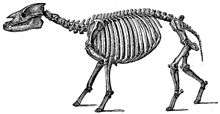Palaeotherium
| Palaeotherium Temporal range: Early to Middle Eocene | |
|---|---|
 | |
| P. magnum skeleton | |
| Scientific classification | |
| Kingdom: | Animalia |
| Phylum: | Chordata |
| Class: | Mammalia |
| Order: | Perissodactyla |
| Family: | †Palaeotheriidae |
| Genus: | †Palaeotherium Cuvier, 1804 |
| Species | |
| |
Palaeotherium ('old beast') is an extinct genus of primitive perissodactyl ungulate.
Taxonomy
George Cuvier originally described them as being a kind of tapir, and as such, Palaeotherium is popularly reconstructed as a tapir-like animal. Recent reexaminations of the skulls show that the nasal cavity was not shaped to support a small trunk, thus starting a recent trend to reconstruct them as looking more horse-like. Recent anatomical studies also suggest that Palaeotherium, along with other palaeothere genera such as Hyracotherium, were closely related to horses.
The average species of Palaeotherium was about 75 cm (2 ft 6 in) tall at the shoulder and lived in the tropical forests covering Europe around 45 million years ago, during the early to mid Eocene.[1] The largest species, P. magnum of Mid Eocene France, grew to be almost as large as a horse.
 Restoration by Heinrich Harder
Restoration by Heinrich Harder Skeletal restoration of P. magnum
Skeletal restoration of P. magnum
References
- ↑ Joomun, S. C.; Hooker, J. J.; Collinson, M. E. (2008). "Dental wear variation and implications for diet: An example from Eocene perissodactyls (Mammalia)". Palaeogeography, Palaeoclimatology, Palaeoecology. 263 (3–4): 92. doi:10.1016/j.palaeo.2008.03.001.
External links

